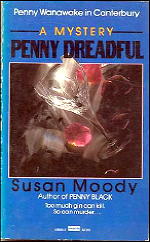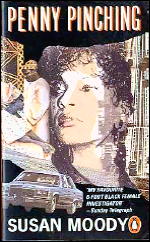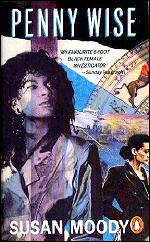Wed 21 Mar 2012
Archived Review: SUSAN MOODY – Penny Dreadful.
Posted by Steve under Authors , Bibliographies, Lists & Checklists , Characters , Reviews[6] Comments
SUSAN MOODY – Penny Dreadful. Fawcett Gold Medal, paperback; 1st US printing, August 1986. First published in the UK: Macmillan, hardcover, 1984.

The Penny in the title refers to Penny Wanawake, girl photographer, whose sleuthing activities place her as as nearly the perfect opposite of Agatha Christie’s Miss Marple as can be imagined. While she is British, Penny is tall, young, black (corn-row braided hairdo), a sophisticated world traveler, and while a possessor of one live-in lover at home, she is not adverse to having others when she’s not.
But returning to the title of this one, it’s at least a double, if not triple, play on words. The dead man in the affair is a writer of cheap blood-and-thunder pulp fiction, supplementing his day job as a schoolmaster at an exclusive boys’ school in Canterbury. Penny dreadfuls, in other words. He’s a dreadful man, too, since his books incorporate much of the scandalous activities his roving eyes have uncovered.
And so no one really minds when he’s found dead. The police think the cause of death was a heart attack. Snooping in the kitchen, Penny finds the smell of gin in the sink, and she wonders if somebody had added something to it before disposing of it. Her interest in the case is not that of bringing a killer to justice, but more of an intellectual exercise in discovering the truth.

There are any number of suspects. Adding to the thrill of the chase is the competition Penny is provided by the visiting policeman from Detroit she is currently sharing living quarters with. On the other hand, though, what Penny Wanawake doesn’t have is a “Watson” to bounce theories off of, and to be bedazzled by her investigative techniques and abilities and so on.
We (the reader) follow her activities through the story from nearly beginning to end, and are usually given access to her thoughts, except (of course) when it really matters. Thus when it comes time for revealing the killer, we find that she had eliminated many possibilities lone before, although there was little in what she said or did that would have allowed us to come to the same conclusions.
Nonetheless, while the story might have moved a bit too slowly for me, I did enjoy Penny Dreadful as a detective puzzle, one populated by people I could see as individuals. Susan Moody has wicked sense of humor, too, maybe even a bit sharper than mine. I could probably quote you parts I liked all day long, but here’s a paragraph I thought you might like. It’ll tell you, at least, what I’m talking about. From pages 141-142:
May 1991 (slightly revised).
The Penny Wanawake series —
Penny Black. Macmillan, 1984.
Penny Dreadful. Macmillan, 1984.
Penny Post. Macmillan, 1985.
Penny Royal. Macmillan, 1986.
Penny Wise. Joseph, 1988.

Penny Pinching. Joseph, 1989.
Penny Saving, Joseph, 1990. No US edition.
All but the last were published by Gold Medal in the US as paperback originals.
After ending the Penny Wanawake series, author Susan Moody began another, this one featuring professional bridge player, Cassandra Swann. Six of the latter’s adventures were recorded between 1993 and 1999, four of them appearing here in the US.
March 21st, 2012 at 1:38 pm
Not being a bridge fan, I’ve never read any of Susan Moody’s “Cassie Swann” series; I may not even own any.
After reading this review, though, I have a strong urge to read more of Penny’s adventures. I meant to at the time, but I have feeling that this is the only one I ever did.
March 23rd, 2012 at 8:18 am
I vaguely remember reading PENNY BLACK, but I don’t remember much about it. And since I didn’t read any more books in the series I suspect it wasn’t to my taste. I can’t imagine a mystery series featuring a bridge player!
March 23rd, 2012 at 11:52 am
Well, time has moved on and we now have mystery series centered on all kinds of hobbies and usual occupations. What’s the difference between a fudge maker and a bridge player?
My own non-interest in bridge notwithstanding.
March 23rd, 2012 at 1:02 pm
I read the first of he “bridge mysteries”. It had little to do with playing bridge, but a murder occurs among the cut-throat competitors in a tournament, and Swann ferrets out the murderer. It was okay. I’ve not read the Penny books or anything else by Moody.
March 23rd, 2012 at 8:18 pm
John Carter of Mars should solve a bridge tournament mystery.
Then everyone should have a party and make fudge.
It could be a Martian Cozy.
(My weird thought for the day.)
March 23rd, 2012 at 9:19 pm
Weird is right, Mike, but I think it would sell. No doubt about it!